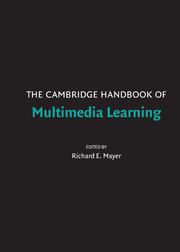Book contents
- Frontmatter
- Contents
- Preface
- Contributors
- 1 Introduction to Multimedia Learning
- PART I THEORETICAL FOUNDATIONS
- PART II BASIC PRINCIPLES OF MULTIMEDIA LEARNING
- 6 Five Common but Questionable Principles of Multimedia Learning
- 7 The Multimedia Principle
- 8 The Split-Attention Principle in Multimedia Learning
- 9 The Modality Principle in Multimedia Learning
- 10 The Redundancy Principle in Multimedia Learning
- 11 Principles for Managing Essential Processing in Multimedia Learning : Segmenting, Pretraining, and Modality Principles
- 12 Principles for Reducing Extraneous Processing in Multimedia Learning : Coherence, Signaling, Redundancy, Spatial Contiguity, and Temporal Contiguity Principles
- 13 Principles of Multimedia Learning Based on Social Cues : Personalization, Voice, and Image Principles
- PART III ADVANCED PRINCIPLES OF MULTIMEDIA LEARNING
- PART IV MULTIMEDIA LEARNING IN CONTENT AREAS
- PART V MULTIMEDIA LEARNING IN ADVANCED COMPUTER-BASED CONTEXTS
- Author Index
- Subject Index
- References
12 - Principles for Reducing Extraneous Processing in Multimedia Learning : Coherence, Signaling, Redundancy, Spatial Contiguity, and Temporal Contiguity Principles
Published online by Cambridge University Press: 05 June 2012
- Frontmatter
- Contents
- Preface
- Contributors
- 1 Introduction to Multimedia Learning
- PART I THEORETICAL FOUNDATIONS
- PART II BASIC PRINCIPLES OF MULTIMEDIA LEARNING
- 6 Five Common but Questionable Principles of Multimedia Learning
- 7 The Multimedia Principle
- 8 The Split-Attention Principle in Multimedia Learning
- 9 The Modality Principle in Multimedia Learning
- 10 The Redundancy Principle in Multimedia Learning
- 11 Principles for Managing Essential Processing in Multimedia Learning : Segmenting, Pretraining, and Modality Principles
- 12 Principles for Reducing Extraneous Processing in Multimedia Learning : Coherence, Signaling, Redundancy, Spatial Contiguity, and Temporal Contiguity Principles
- 13 Principles of Multimedia Learning Based on Social Cues : Personalization, Voice, and Image Principles
- PART III ADVANCED PRINCIPLES OF MULTIMEDIA LEARNING
- PART IV MULTIMEDIA LEARNING IN CONTENT AREAS
- PART V MULTIMEDIA LEARNING IN ADVANCED COMPUTER-BASED CONTEXTS
- Author Index
- Subject Index
- References
Summary
Abstract
Extraneous overload occurs when essential cognitive processing (required to understand the essential material in a multimedia message) and extraneous cognitive processing (required to process extraneous material or to overcome confusing layout in a multimedia message) exceeds the learner's cognitive capacity. Five multimedia design methods intended to minimize extraneous overload are the coherence, signaling, redundancy, spatial contiguity, and temporal contiguity principles. The coherence principle is that people learn more deeply from a multimedia message when extraneous material is excluded rather than included. This principle was supported in 10 out of 11 experimental tests, yielding a median effect size of 1.32. The signaling principle is that people learn more deeply from a multimedia message when cues are added that highlight the organization of the essential material. This principle was supported in three out of three experimental tests, yielding a median effect size of 0.60. The redundancy principle is that people learn more deeply from graphics and narration than from graphics, narration, and on-screen text. This principle was supported in 10 out of 10 experimental tests, yielding a median effect size of 0.69. The spatial contiguity principle is that people learn more deeply from a multimedia message when corresponding words and pictures are presented near rather than far from each other on the page or screen. This principle was supported in eight out of eight experimental tests, yielding a median effect size of 1.11. The temporal contiguity principle is that people learn more deeply from a multimedia message when corresponding animation and narration are presented simultaneously rather than successively.
- Type
- Chapter
- Information
- The Cambridge Handbook of Multimedia Learning , pp. 183 - 200Publisher: Cambridge University PressPrint publication year: 2005
References
- 114
- Cited by

